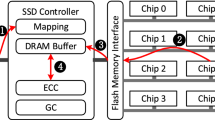Abstract
Flash Translation Layer (FTL) is the device driver software that makes flash memory device appear to the system like a disk drive. Since flash memory cannot be written over existing data unless erased in advance, the FTL usually employs special address mapping algorithms to avoid having to erase on every data update. In this paper, we propose a new FTL algorithm which considers the access patterns of data blocks. Proposed scheme monitors write access patterns of data blocks and intelligently manages the address mapping to improve the performance. Simulation results show that the proposed scheme improves the space utilization without significant write/update performance degradation.
This work was supported by the Korea Research Foundation Grant funded by the Korean Government(MOEHRD)(R08-2004-000-10391-0).
Preview
Unable to display preview. Download preview PDF.
Similar content being viewed by others
References
Chang, L., Kuo, T.: An adaptive striping architecture for flash memory storage systems of embedded systems. In: Proceedings of the 8th IEEE Real-Time and Embedded Technology and Applications Symposium (2002)
Chang, L., Kuo, T.: An efficient management scheme for large-scale flash memory storage systems. In: Proceedings of ACM Symposium on Applied Computing (2004)
Chiang, M., Chang, R.: Cleaning policies in mobile computers using flash memory. Journal of Systems and Software 48(3), 213–231 (1999)
Chung, T., Park, D., Ryu, Y., Hong, S.: Lstaff: System software for large block flash memory. In: Baik, D.-K. (ed.) AsiaSim 2004. LNCS (LNAI), vol. 3398, pp. 704–710. Springer, Heidelberg (2005)
Intel Corporation. Intel strataflash memory product overview, http://www.intel.com
Intel Corporation. Understanding the flash translation layer (ftl) specification (December 1998), http://developer.intel.com
Douglis, F., Caceres, R., Kaashoek, F., Li, K., Marsh, B., Tauber, J.: Storage alternatives for mobile computers. In: Proceedings of the 1st Symposium on Operating Systems Design and Implementation (1994)
Samsung Electronics. 256m x 8bit / 128m x 16bit nand flash memory, http://www.samsungelectronics.com
Kim, J., Noh, S., Min, S., Cho, Y.: A space-efficient flash translation layer for compactflash systems. IEEE Trans. on Consumer Electronics 48(2), 366–375 (2002)
M-Systems. Trueffs, http://www.m-systems.com/
Marsh, B., Douglis, F., Krishnan, P.: Flash memory file caching for mobile computers. In: Proceedings of the 27th Hawaii International Conference on Systems Sciences (1994)
Ruemmler, C., Wilkes, J.: Unix disk access patterns. In: Proceedings of 1993 Winter USENIX Conference, pp. 405–420 (1993)
Wu, M., Zwanepoel, W.: envy: A non-volatile, main memory storage system. In: Proceedings of the 6th Internation Conference on Architectural Support for Programming Languages and Operating Systems (1994)
Yim, K., Bahn, H., Koh, K.: A flash compression layer for smartmedia card systems. IEEE Trans. on Consumer Electronics 50(1), 192–197 (2004)
Author information
Authors and Affiliations
Editor information
Editors and Affiliations
Rights and permissions
Copyright information
© 2005 Springer-Verlag Berlin Heidelberg
About this paper
Cite this paper
Ryu, Y., Lee, K. (2005). Improvement of Space Utilization in NAND Flash Memory Storages. In: Yang, L.T., Zhou, X., Zhao, W., Wu, Z., Zhu, Y., Lin, M. (eds) Embedded Software and Systems. ICESS 2005. Lecture Notes in Computer Science, vol 3820. Springer, Berlin, Heidelberg. https://doi.org/10.1007/11599555_74
Download citation
DOI: https://doi.org/10.1007/11599555_74
Publisher Name: Springer, Berlin, Heidelberg
Print ISBN: 978-3-540-30881-2
Online ISBN: 978-3-540-32297-9
eBook Packages: Computer ScienceComputer Science (R0)




